This former Roman Catholic church was built in c1844 on the site of the old Black Bull Inn which has given its name to this Wetherspoon pu
Prints and text about The Black Bull Inn.
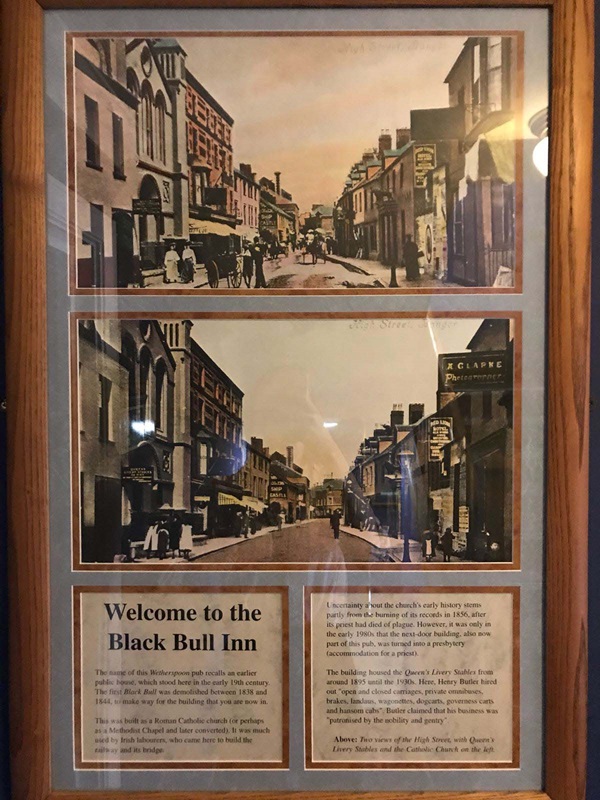
The text reads: The name of this Wetherspoon pub recalls an earlier public house, which stood here in the early 19th century. The first Black Bull was demolished between 1838 and 1844, to make way for the building that you are now in.
This was built as a Roman Catholic church (or perhaps as a Methodist Chapel and later converted). It was much railway and its bridge.
Uncertainty about the church’s early history stems partly from the burning of its records in 1856, after its priest had died of plaque. However, it was only in the early 1980s that the next door building, also now part of this pub, was turned into presbytery (accommodation for a priest).
The building housed the Queen’s Livery Stables from around 1895 until the 1930s. Here, Henry Butler hired out “open and closed carriages, private omnibuses, brakes, landaus, wagonettes, dogcarts, governess carts and hansom cabs”. Butler claimed that his business was “patronised by the nobility and gentry”.
Above: Two views of the High Street, with Queen’s Livery Stables and the Catholic church on the left.
Photographs and text about The Black Bull.
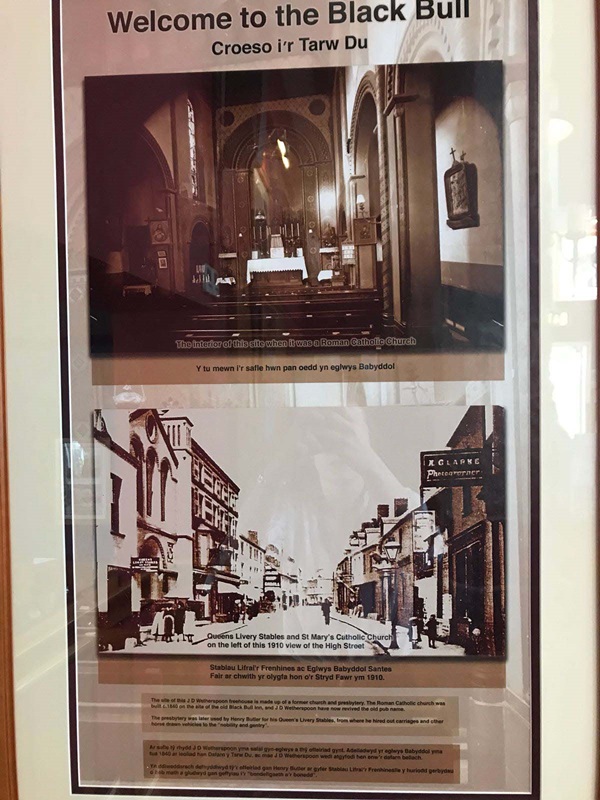
The text reads: The site of this Wetherspoon freehouse is made up of a former church and presbytery. The Roman Catholic church was built c1840 on the site of the old Black Bull Inn, and JD Wetherspoon have now revived the old pub name.
The presbytery was later used by Henry Butler for his Queen’s Livery Stables, from where he hired out carriages and other horse drawn vehicles to the nobility and gentry.
Illustrations and text about the Menai Bridge.
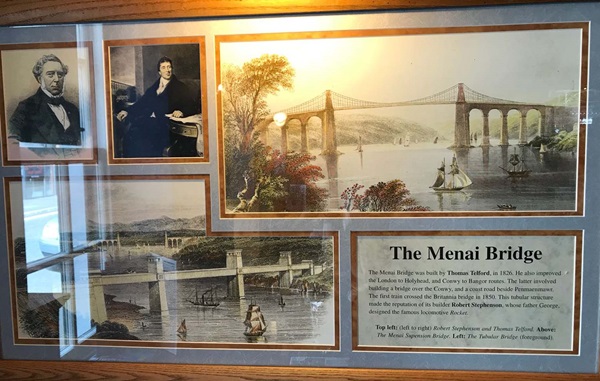
The text reads: The Menai Bridge was built by Thomas Telford, in 1826. He also improved the London to Holyhead, and Conwy to Bangor routes. The latter involved building a bridge over the Conwy, and a coast road beside Penmaenmawr. The first train crossed the Britannia Bridge in 1850. This tubular structure made the reputation of its builder Robert Stephenson; whose father George designed the famous locomotive Rocket.
Top left: (left to right) Robert Stephenson and Thomas Telford, Above: The Menai Suspension Bridge
Left: The Tubular Bridge (foreground).
Photographs and text about University College.
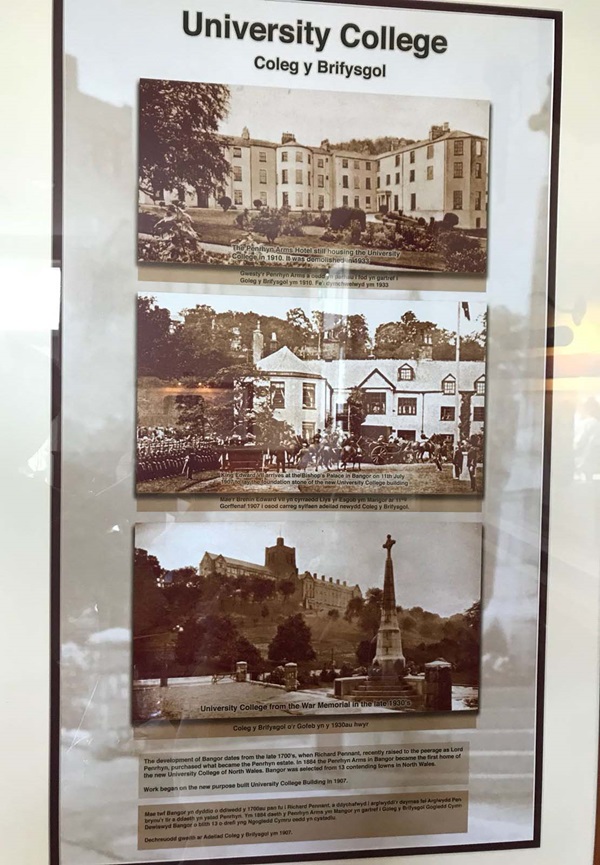
The text reads: The development of Bangor dates from the late 1700s, when Richard Pennant, recently raised to the peerage as Lord Penrhyn, purchased what became the Penrhyn estate. In 1884 the Penrhyn Arms in Bangor became the first home of the new University College of North Wales. Bangor was selected from 13 contending towns in North Wales. Work began on the new purpose built University College Building in 1907.
Prints and text about local locals.
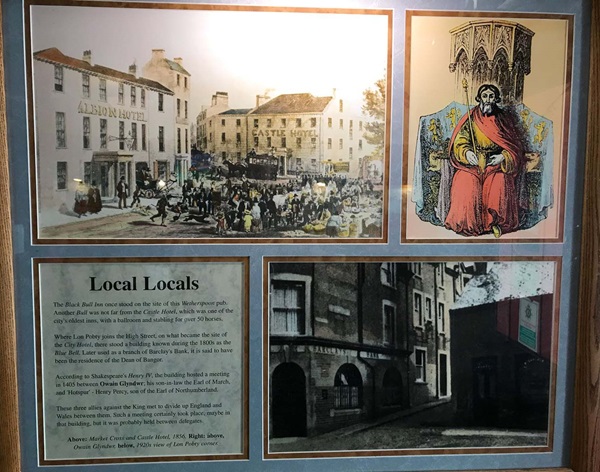
The text reads: The Black Bull Inn once stood on the site of this Wetherspoon pub. Another bull was not far from the Castle Hotel, which was one of the city’s oldest inns, with a ballroom and stabling for over 50 horses.
Where Lon Pobty joins the High Street, on what became the site of the City Hotel, there stood a building known during the 1800s as the Blue Bell. Later used as a branch of Barclay’s Bank, it is said to have been the residence of the Dean of Bangor.
According to Shakespeare’s Henry IV, the building hosted a meeting in 1405 between Owain Glyndwer; his son-in-law the Earl of March, and ‘Hotspur’ – Henry Percy, son of the Earl of Northumberland.
These three allies against the King met to divide up England and Wales between them. Such a meeting certainly took place, maybe in the building, but it was probably held between delegates.
Above: Market Cross and Castle Hotel, 1856 Right: above, Owain Glyndwr, below, 1920s view of Lon Pobty corner.
Illustrations and text about the Cathedral.
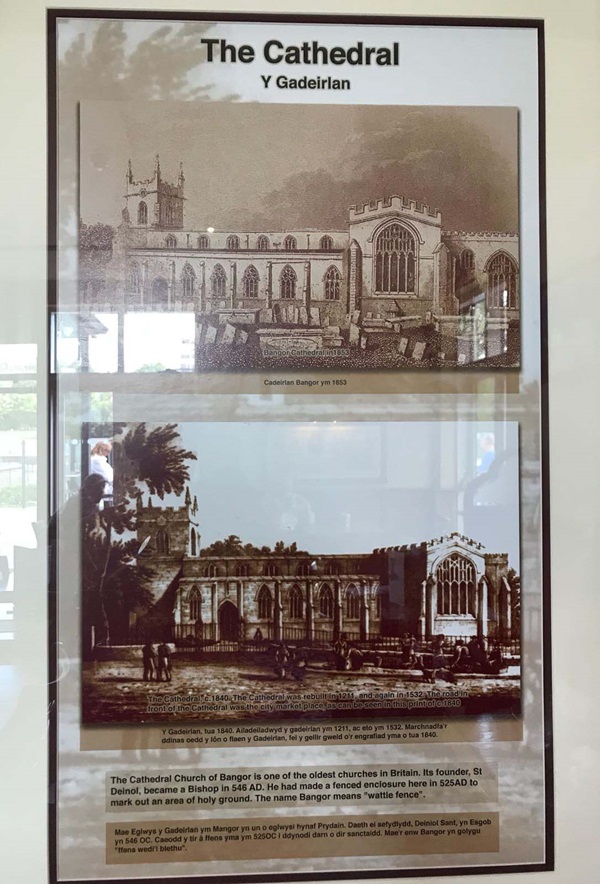
The text reads: The Cathedral Church of Bangor is one of the oldest churches in Britain. Its founder, St Deinol, became a bishop in 546AD. He had made a fenced enclosure here in 525AD to mark out an area of holy ground. The name Bangor means “wattle fence”.
Illustrations and text about development in Bangor.
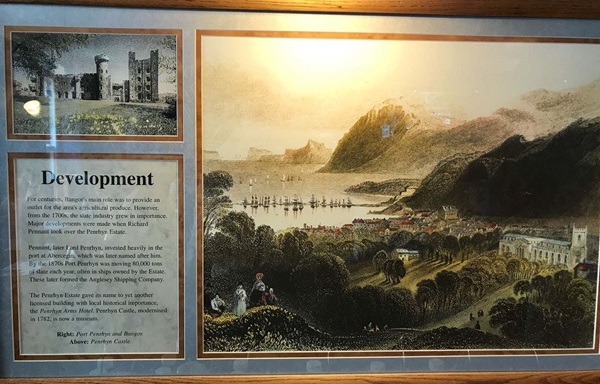
The text reads: For centuries, Bangor’s main role was to provide an outlet for the area’s agricultural produce. However, from the 1700s, the slate industry grew in importance. Major developments were made when Richard Pennant took over the Penrhyn Estate.
Pennant, later Lord Penrhyn, invested heavily in the port at Abercegin, which was later named after him. By the 1870s Port Penrhyn was moving 80,000 tons of slate each year, often in ships owned by the Estate. These later formed the Anglesy Shipping Company.
The Penrhyn Estate gave its name to yet another licensed building with local historical importance, the Penrhyn Arms Hotel. Penrhyn Castle, modernised in 1782, is now a museum.
Right: Port Penrhyn and Bangor
Above: Penrhyn Castle.
Illustrations and text about the Menai and Britannia Bridges.
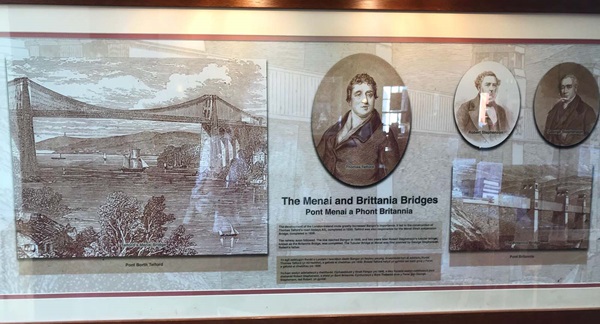
The text reads: The development of the London-Ireland route greatly increased Bangor’s importance. It lead to the construction of Thomas Telford’s road, completed in 1830. Telford was also responsible for the Menial Strait suspension Bridge, completed in 1856.
The railway soon followed, the line reached Bangor in 1868 and two years later father Robert Stephenson’s bridge, known as the Britannia Bridge, was completed.
Prints and text about St Deiniol and his cathedral.
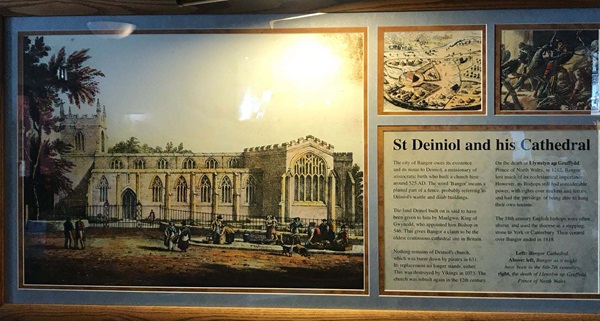
The text reads: The city of Bangor owes its existence and its name to Deiniol, a missionary of aristocratic birth who built a church here around 525 AD. The word ‘Bangor’ means a plaited part of a fence, probably referring to Deiniol’s wattle and daub buildings.
The land Deinol built on is said to have been given him by Maelgwn, King of Gwynedd, who appointed hip Bishop in 546. This gives Bangor a claim to be the oldest continuous cathedral site in Britain.
Nothing remains of Deiniol’s church, which was burnt down by pirates in 631. Its replacement no longer stands, either. This was rebuilt again in the 12th century.
On the death of Llywelyn ap Gruffydd, Prince of North Wales, in 1282. Bangor lost much of its ecclesiastical importance. However, its Bishops still had considerable power, with rights over markets and ferries, and had the ‘privilege’ of being able to hang their own tenants.
The 18th century English bishops were often absent, and used the diocese as a stepping-stone to York or Canterbury. Their control over Bangor ended in 1818.
Left: Bangor Cathedral
Above: left, Bangor as it might have been in the 6th-7th centuries, right, the death of Llewelyn ap Gruffydd, Prince of North Wales.
External photograph of the building – main entrance.
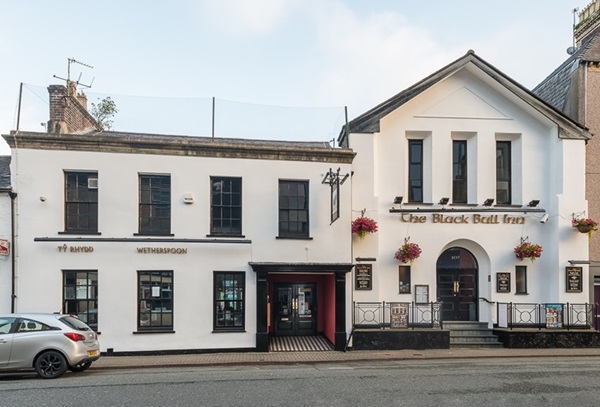
If you have information on the history of this pub, then we’d like you to share it with us. Please e-mail all information to: pubhistories@jdwetherspoon.co.uk